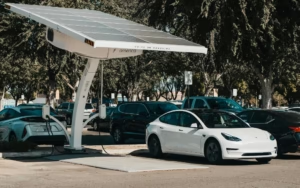The rise of electric vehicles across Australia is more than just a shift in energy sources. It represents a major transformation in how cars are designed, built, and used. One of the most significant factors behind this change is the range of technological advancements in EVs. These innovations are making electric vehicles faster, safer, smarter and more efficient. From enhanced battery technology to intelligent software, technological advancements in EVs are changing the driving experience and boosting the adoption of electric vehicles in Australia.
In recent years, Australia’s transport landscape has rapidly evolved, driven by government incentives, rising fuel prices, and a strong push towards environmental sustainability. But at the heart of this change is the technology inside the vehicles themselves. This article explores the key technological advancements in EVs, how they benefit Australian drivers, and what the future holds for this growing sector.
The Role of Battery Technology in Technological Advancements in EVs
One of the most critical technological advancements in EVs is battery innovation. The power, range, and charging speed of an electric vehicle are directly linked to the type of battery it uses.
Australian drivers are increasingly looking for EVs that can travel long distances on a single charge. The latest lithium-ion batteries offer improved energy density, allowing modern EVs to travel over 500 kilometres before needing a recharge. This development is particularly important in a country like Australia, where long-distance driving is common.
In addition to lithium-ion batteries, newer technologies such as solid-state batteries are showing promise. These batteries are lighter, more stable, and have the potential to increase driving range even further. As solid-state technology becomes more commercially viable, it will be a major leap forward in the technological advancements in EVs.
Charging times have also improved. Fast-charging stations now allow some EVs to reach 80 percent charge in under 30 minutes. This convenience is essential for reducing charging anxiety and encouraging more Australians to make the switch.
Smart Charging Infrastructure in Australia
Another area where technological advancements in EVs are evident is the development of smart charging systems. In Australia, public and home charging stations are getting smarter, offering features like scheduling, remote monitoring, and energy-efficient charging.
Smart chargers can automatically adjust power usage depending on the electricity load of your home or the grid. This is particularly useful in Australia, where many homes rely on solar energy. With smart charging, EVs can be programmed to charge during periods of high solar production, making the most of renewable energy and saving money.
Vehicle-to-grid (V2G) technology is also gaining attention. This allows EVs not just to charge from the grid, but to send power back to it. For Australian households with solar panels, V2G can create a two-way energy flow, turning electric vehicles into mobile batteries.
All these developments represent major technological advancements in EVs and highlight how integrated the vehicle and energy systems are becoming.

Enhanced Driving Experience through Connected Technology
Modern electric vehicles are more than just transport machines. They are highly connected devices that improve the overall driving experience. Many of these features are powered by software that is constantly updated, a clear example of the technological advancements in EVs.
Australian EV drivers now enjoy features such as real-time navigation updates, traffic prediction, voice assistants, and over-the-air updates. Tesla, for instance, sends software updates remotely to its vehicles, enhancing performance, adding new features, and improving safety without requiring a visit to the dealership.
These updates help Australian EVs stay current with the latest driving technologies. Connectivity also means better integration with mobile apps, allowing users to check battery levels, preheat or cool their vehicle, and schedule charging from their phone.
This digital integration is a growing part of the technological advancements in EVs, making driving more seamless, personalised, and enjoyable.
Autonomous Driving and Driver Assistance Features
Autonomous driving has been a hot topic for several years, and while fully self-driving cars are still in development, semi-autonomous features are already available in many electric vehicles in Australia. These features are key components of the broader technological advancements in EVs.
Driver assistance systems such as adaptive cruise control, lane keeping assist, and automatic emergency braking are becoming standard in EVs. These technologies use sensors, cameras, and radar systems to monitor surroundings and assist the driver.
Companies like Tesla, Hyundai, and BYD are including such features in their EV models available in Australia. Some of the more advanced systems can even change lanes automatically, park the car, or alert drivers to nearby hazards.
Although regulations around autonomous driving are still evolving in Australia, the technology is advancing rapidly. These innovations are helping to improve road safety and reduce driver fatigue, which are important benefits of the technological advancements in EVs.
Improved Vehicle Efficiency through Aerodynamic Design and Lightweight Materials
Efficiency is crucial for electric vehicles. The more energy an EV can save, the longer it can drive. Recent technological advancements in EVs have focused heavily on improving efficiency through vehicle design.
Modern EVs use aerodynamic shapes to reduce drag. Manufacturers pay close attention to every curve and angle to make the vehicle move more smoothly through air. This is especially important in Australia’s varied landscapes, from busy cities to open highways.
Lightweight materials such as aluminium and carbon fibre are also being used more widely. Reducing the weight of the vehicle helps improve both performance and battery range. Many new EVs in Australia feature a mix of lightweight metals and composite panels to strike the right balance between strength and efficiency.
All of these design choices contribute to the broader technological advancements in EVs, helping drivers go further on less energy.
Regenerative Braking Systems Saving Energy on the Go
Regenerative braking is a key innovation in electric vehicles that helps to extend driving range. Instead of wasting energy during braking, EVs with regenerative systems capture that energy and send it back to the battery.
This process not only improves efficiency but also reduces wear and tear on traditional braking components. For Australian drivers, especially those navigating hilly areas or frequent stop-and-go traffic in cities, regenerative braking offers practical benefits.
Nearly all new electric cars sold in Australia today come with some form of regenerative braking. It is another example of how technological advancements in EVs focus on getting the most out of every bit of energy.
Sustainability through Eco-Friendly Manufacturing Practices
While the environmental benefit of driving an EV is well-known, fewer people realise how sustainable the manufacturing process has become. As part of the ongoing technological advancements in EVs, automakers are now adopting greener methods of production.
Manufacturers are investing in low-emission factories, using recycled materials for vehicle interiors, and sourcing batteries more responsibly. Companies are also working to ensure that the mining of lithium and cobalt, essential for EV batteries, is done in a more ethical and sustainable manner.
In Australia, the push for local battery production and resource processing is growing. The country is rich in lithium and other essential minerals, and technological improvements are helping to turn these raw materials into high-quality battery products.
This commitment to sustainability is another vital piece of the puzzle when discussing technological advancements in EVs.
Artificial Intelligence and Machine Learning Integration
Artificial intelligence is playing a major role in shaping the next generation of electric vehicles. From personalising driver preferences to improving safety, AI is one of the most exciting areas within the technological advancements in EVs.
Some EVs are now equipped with AI-powered voice recognition systems that learn how you speak and adapt to your commands. Others use machine learning to adjust climate controls, driving modes, or charging patterns based on your habits.
AI also improves safety by processing data from sensors faster and more accurately than a human driver could. This leads to better obstacle detection, predictive maintenance, and quicker response times in emergency situations.
In Australia, as the digital infrastructure continues to grow, the integration of AI in EVs will become more common. It represents a powerful step forward in the ongoing technological advancements in EVs.
Customisation and Modular Designs for the Australian Market
One trend gaining momentum is the move towards modular vehicle design. These customisable platforms allow manufacturers to offer different types of vehicles using the same base structure. This flexibility is part of the broader technological advancements in EVs that make production more efficient and products more adaptable.
For the Australian market, where both urban and regional drivers have very different needs, modular EV platforms allow companies to offer hatchbacks, SUVs, and utes without creating separate production lines.
It also allows for quicker updates and feature upgrades. A single EV platform can be used to introduce new technologies, improving the speed at which innovation reaches consumers.
This efficient approach to design is making EVs more accessible across Australia and shows how technological advancements in EVs are shaping the market to meet diverse needs.
The Rise of Software-Defined Vehicles
Traditionally, cars were mechanical machines. Today, electric vehicles are increasingly defined by software. Known as software-defined vehicles (SDVs), these cars rely heavily on code to control everything from performance to entertainment systems.
Australian EV owners are now familiar with vehicles that improve after purchase thanks to software updates. Whether it’s better battery management, new safety features or app-based controls, the experience of owning an EV is increasingly digital.
The move toward SDVs is part of a larger trend of technological advancements in EVs, where the car becomes an evolving product that gets smarter over time.






